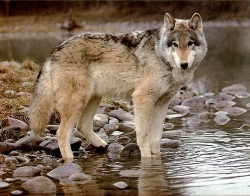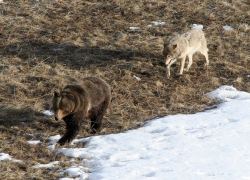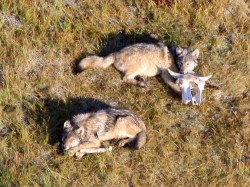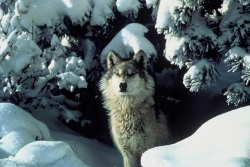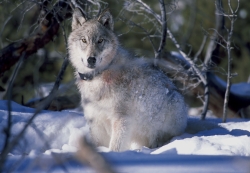
Courtesy US FWS, William Campbell, Photographer
Thank goodness, we have awakened to the value of predators in maintaining healthy ecosystems, and for their aesthetic and spiritual value. After all, they coexisted along with their prey for millions of years before our species came along and began tinkering.
There are well-documented visits by these two species in Utah, including actual tactile experience. However, established breeding populations are yet to be found. Both require vast, relatively undisturbed wildlands to thrive.
Since wolves were reintroduced in Yellowstone in 1995, the Utah DWR has been able to confirm 20 wolves in our state. Nearly all confirmed sightings have been consistent with lone, dispersing wolves.
Due to a recent court ruling, wolves in much of Utah are once again listed as endangered under the federal Endangered Species Act except a small portion of northern Utah where wolves are not welcome. There is a statewide wolf management plan and personnel to manage them. Any wolves that move out of the small, delisted area are considered endangered and are subject to exclusive federal jurisdiction.
A wolverine was recently spotted in Rich County, now wandering the Uinta Mountains with a GPS collar around its neck. This is the first wolverine ever captured in Utah history. The wolverine is a male, between 3-4 years old, and biologists say he is in excellent physical condition. They are excited to learn more about this elusive animal with only eight confirmed sightings in Utah since 1979. We are on the southern edge of the wolverine’s typical habitat. This GPS tracking will allow us to understand and manage wolverines in Utah.
Now on to Yellowstone where both species are well established. Around a hundred wolves in 8 packs, and about 7 wide ranging wolverines may be found in the park. Climate-change models predict that by 2050, the spring snowpack needed for wolverine denning and hunting will make the greater Yellowstone ecosystem a critical part of its southern range. Wolverines are so rarely seen and inhabit such remote terrain at low densities that assessing population trends is difficult and sudden declines could go unnoticed for years.
I doubt we will see a wolverine on our visit, but wolf sightings are a good bet as we will be led by a park wolf technician, that is if we don’t succumb to hypothermia before a howl is heard!
Jack Greene for Bridgerland Audubon Society. With confirmed sightings of wolves and wolverine in our state, I’m even wilder about Utah!
Credits:
Pictures: Courtesy US National Parks Service, William Campbell, Photographer
Audio: Courtesy & Copyright J. Chase and K.W. Baldwin, https://upr.org/
Text: Jack Greene, Bridgerland Audubon, https://bridgerlandaudubon.org/
Additional Reading: Lyle W Bingham, Webmaster, and Jack Greene, Author, Bridgerland Audubon, https://bridgerlandaudubon.org/
Additional Reading:
Jack Greene’s Postings on Wild About Utah, https://wildaboututah.org/author/jack/
Wolves in Utah, Utah Division of Wildlife Resources, Utah Department of Natural Resources, State of Utah, Last Updated: Thursday, March 3, 2022, https://wildlife.utah.gov/wolves.html#:~:text=Are%20there%20wolves%20in%20Utah,20%20wolves%20in%20the%20state.
Gray wolves again listed as endangered in most of Utah, A recent court ruling limits wolf-management options, Utah Division of Wildlife Resources, Utah Department of Natural Resources, State of Utah, March 1, 2022, https://wildlife.utah.gov/wolf/wolves.pdf
Podmore, Zak, (Report for America), A gray wolf is in Utah for the first time in years. The state is setting traps, The Salt Lake Tribune, June 3, 2020, https://www.sltrib.com/news/2020/06/03/gray-wolf-is-utah-first/
Wolverine captured, collared and released in Utah, Utah Division of Wildlife Resources, Utah Department of Natural Resources, State of Utah, March 14, 2022, https://wildlife.utah.gov/news/utah-wildlife-news/1380-wolverine-captured-collared-and-released-in-utah.html
Miller, Jordan, Wolverine spotted in Utah this month marks third publicized sighting this year, The Salt Lake Tribune, Oct. 20, 2021, https://www.sltrib.com/news/2021/10/20/wolverine-spotted-utah/


